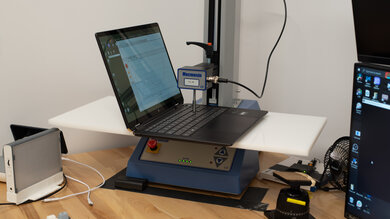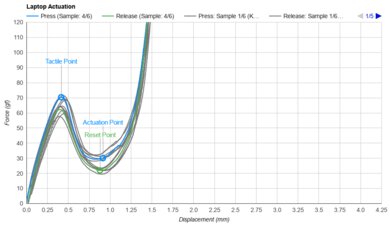
While touch input isn't absolutely necessary on a laptop, it provides an additional way to interact with the device and can sometimes make navigation easier and more natural. These days, there are tons of laptops with a touchscreen, including traditional clamshell models, 2-in-1 convertibles, and tablets with detachable keyboards. So, to help you sort through all the available options, we've compiled a list of the best we've tested. There won't be any MacBooks in this article because there aren't any MacBooks with a touchscreen.
We've tested more than 125 laptops, and below are our recommendations for the best touchscreen laptops. You can also check out our recommendations for the best laptops, the best laptops for college, and the best business laptops.
-
Best Touchscreen Laptop
School8.4Gaming7.1Multimedia8.6Workstation8.1Business8.2Form Factor2 in 1Portability8.6Typing Quality8.0Touchpad8.8Ports7.0Battery Life (Web Browsing)11.0 hrsThe best touchscreen laptop we've tested is the HP Spectre x360 14 (2024). This premium 2-in-1 convertible has a thin and light design, a sturdy all-aluminum build, and an 11-hour battery life, making it a great laptop for on-the-go use. It sports a gorgeous 2.8k, 120Hz OLED display, which, in addition to touch input, also supports pen input. The keyboard feels spacious and tactile, and the touchpad is large and easy to use. You get a decent port selection for peripherals and external displays, including one USB-A and two USB-C/Thunderbolt 4s. For biometrics, there's both a fingerprint sensor and a facial recognition IR camera, so you can log in quickly and get straight to work.
Performance is great; Intel's Core Ultra CPUs can easily handle general productivity tasks like text processing, web browsing, and video playback, as well as more demanding workloads like photo editing and programming. The laptop doesn't get overly hot or loud, so you don't have to worry about causing too much noise in a quiet work environment. Two things to bear in mind about the display: the OLED panels flicker at 480Hz, which may bother people sensitive to display flicker, and OLEDs are susceptible to permanent burn-in, especially with static elements like Windows' taskbar, so you'll want to make sure to vary the content on your screen.
-
Best Mid-Range Touchscreen Laptop
School7.9Gaming4.6Multimedia8.1Workstation6.9Business7.8Form Factor2 in 1Portability8.4Typing Quality9.0Touchpad7.4Ports7.0Battery Life (Web Browsing)10.1 hrsFor our mid-range pick, we recommend the Acer Chromebook Plus Spin 714 (2024). This 14-inch Chromebook offers solid build quality and a great user experience. Its IPS touchscreen display looks vibrant, and in addition to touch input, it has USI stylus support (although the stylus isn't included with the laptop). The only downside is the display's poor reflection handling; it isn't suitable for use in bright environments, as any direct light sources like lamps or the sun will be visible. On the bright side (no pun intended), its performance is great. It comes with Intel's latest Core Ultra CPUs which can easily handle general productivity tasks like spreadsheets and word processing, and some are powerful enough for intensive tasks. Its keyboard and touchpad are easy and comfortable to use, and the webcam is fantastic, offering a clear image. Its battery life is great at over 10 hours of light use so a single charge is enough for a typical workday. Of course, not every piece of software is compatible with ChromeOS, so be sure to check for compatibility if you need to use any specialized programs.
If you don't want to worry about software compatibility with ChromeOS, consider the Lenovo Yoga 6 13 (2023), a Windows alternative. This 13-inch convertible laptop feels better built than many other models in its class. Its FHD+ IPS touchscreen display is great for productivity tasks, as it offers more vertical real estate than a more traditional 16:9 aspect ratio. However, similar to the Acer, don't expect to be able to use it comfortably in direct sunlight as it isn't the brightest display. Unlike the Acer, this laptop comes with older Zen 3-based AMD Ryzen 7000 series mobile processors. This laptop can easily handle general productivity tasks like spreadsheets or word processing, but you aren't getting the latest features. As for the interface, you get quite a large touchpad for a 13-inch laptop and a great backlit keyboard. Its battery life is also excellent, lasting up to 10 hours of light use or nine hours for video playback. If you have trouble finding it, you can get it directly from Lenovo's website.
-
Best Budget Touchscreen Laptop
School7.4Gaming5.9Multimedia7.2Workstation6.9Business7.3Form FactorTraditional (Clamshell)Portability8.0Typing Quality7.0Touchpad6.5Ports7.0Battery Life (Web Browsing)9.3 hrsThe best budget touchscreen laptop we've tested is the Lenovo IdeaPad 3 15 (2021). As this is an older model from 2021, you can easily find an AMD Ryzen 5 5500U configuration for around $500. The Ryzen 5 5500U CPU is a few years old but still plenty fast for general productivity tasks like web browsing, text processing, spreadsheets, and presentations. Its battery life sits around nine hours of light use, just enough to get you through a typical eight-hour workday.
This laptop is pretty easy to carry around for a 15.6-inch model. Its metal-and-plastic construction feels relatively sturdy—fair for the price but nothing special. You get a reasonably bright 1080p display, a 720p webcam, and a fingerprint sensor. As for the keyboard and touchpad, the former feels tactile but slightly tiring, and the latter is small but reasonably responsive. Unfortunately, you can only charge the laptop via the barrel plug connector because the USB-C port doesn't support charging, and the HDMI port only supports HDMI 1.4 standards, limiting the output resolution to 4k @ 30Hz.
-
Best Cheap Touchscreen Laptop
School7.6Gaming4.1Multimedia7.6Workstation5.3Business7.1Form FactorTraditional (Clamshell)Portability7.8Typing Quality6.5Touchpad6.1Ports7.0Battery Life (Web Browsing)13.3 hrsIf you have an extremely tight budget and want to spend as little as possible, get the Lenovo IdeaPad Slim 3i Chromebook 14 (2023). You can regularly find the Core i3 configuration (paired with an FHD display, 8GB of RAM, and 128GB of storage) for around $350 to $500 USD on Lenovo's website. The Core i3-N305 CPU can handle light productivity tasks like text processing, web browsing, and video playback; just don't expect to do anything intensive like video editing. The cheaper configurations with an Intel N100 or N200 CPU and/or 4GB of RAM are fine if you have an extremely light workload, but know that you'll experience more slowdowns when multitasking.
Admittedly, this 14-inch Chromebook looks pretty cheap design-wise; however, it's very compact, and its battery lasts around 13 hours of light use. As for the display, while there are multiple options, only the FHD IPS panel with 100% sRGB coverage supports touch input. It looks sharp and gets bright enough for use in most indoor settings. Above it is an excellent 1080p webcam, so your colleagues and clients can see and hear you clearly on video calls. Unfortunately, the keyboard feels a tad mushy, and the touchpad is small and sometimes unresponsive.
-
Best Touchscreen Workstation Laptop
School7.9Gaming7.6Multimedia8.6Workstation8.8Business8.0Form FactorTraditional (Clamshell)Portability7.2Typing Quality7.5Touchpad7.4Ports6.5Battery Life (Web Browsing)9.5 hrsThe best touchscreen workstation laptop we've tested is the Dell XPS 16 (2024). Replacing the Dell XPS 17 from 2023, this 16.3-inch premium model sports Dell's new XPS design with edge-to-edge keys, an invisible touchpad, and impossibly thin bezels. It's available with Intel Meteor Lake CPUs paired with integrated graphics or an NVIDIA discrete GPU, up to an RTX 4070, giving you enough processing power to tackle general productivity tasks and intensive workloads like programming, video editing, and 3D modeling. RAM and storage max out at 64GB and 4TB, respectively. The RAM isn't user-replaceable, but the SSD is. Its battery life is good at around nine to 10 hours of light use on a model with a Core Ultra 9 processor and RTX 4060—you'll get even more on models with integrated graphics only.
In terms of the user experience, it's somewhat of a mixed bag. While the new design looks sleek and futuristic, it might take some time to get used to, as the keyboard's edge-to-edge keys can cause more typos (due to the lack of space between the keys), and because the touchpad is invisible, you can sometimes be right at the edge where the tracking is a little inconsistent, causing frustration. As for the display, you can choose between a 120Hz FHD+ IPS or a 90Hz 4k+ OLED panel, though only the latter supports touch input. You get Wi-Fi 7 wireless connectivity, a fingerprint sensor, a facial recognition camera for quick logins, and an okay port selection with three USB-C Thunderbolt 4s and a MicroSD card reader.
Notable Mentions
- ASUS Zenbook 14 OLED (2024): The ASUS Zenbook 14 OLED (2024) is a cheaper alternative to the HP Spectre x360 14 (2024). Unfortunately, it doesn't perform as well because its CPU throttles significantly under load, and its battery life is shorter at around eight hours of light use. Also, it isn't a 2-in-1 convertible, so you can't use it as a tablet. See our review
- ASUS Zenbook 14 Flip OLED (2023): The ASUS Zenbook 14 Flip OLED (2023) is a 2-in-1 convertible and a great alternative to the HP Spectre x360 14 (2024). It provides a similar user experience and has an HDMI port, but its CPU throttles a lot, and its battery life is shorter. See our review
- Lenovo Chromebook Duet 5 (2021): The Lenovo Chromebook Duet 5 (2021) is a good alternative to the Lenovo IdeaPad 3 15 (2021) if you only need a device for media consumption. It has a nicer OLED display, and you can detach the keyboard to save space. However, the keyboard feels less comfortable to type on, and its port selection is significantly worse. See our review
Recent Updates
-
Aug 21, 2024: Due to availability, we've replaced the Lenovo Yoga 7i 16 (2023) with the Acer Chromebook Plus Spin 714 (2024) as the 'Best Mid-Range Touchscreen Laptop' and removed the Dell Inspiron 16 2-in-1 (2023) from our Notable Mentions. We've also reviewed the article for clarity.
-
May 28, 2024: Minor structure change to add a 'Best Workstation' category since it's less relevant to the average user. Replaced the ASUS Zenbook 14 Flip OLED (2023) with the HP Spectre x360 14 (2024) because the HP provides a better user experience overall. Replaced the Dell XPS 15 (2023) with the Dell XPS 16 (2024) because the XPS 15 is discontinued and hard to find. Removed the Lenovo ThinkPad X1 Carbon Gen 11 (2023) from the Notable Mentions because better options are available.
-
Mar 29, 2024: Small text edits to provide information regarding new Dell XPS laptops. Removed the Lenovo Slim Pro 7 14 (2023) from the Notable Mentions because it's discontinued and hard to find. Added the ASUS Zenbook 14 OLED (2024) as a Notable Mention.
-
Feb 01, 2024: Verified that all picks are still valid and made minor text changes to improve clarity. The recommendations remain the same.
-
Dec 04, 2023: Replaced the Lenovo Chromebook C340 15 (2020) with the Lenovo IdeaPad Slim 3i Chromebook 14 (2023) because the C340 is near the end of its OS support.
All Reviews
Our recommendations above are what we think are currently the best touchscreen laptops you can get. In addition to the test results, we factor in the price, feedback from our visitors, and availability.
If you prefer to make your own decision, here’s the list of all of our laptop reviews, sorted by price from low to high. Keep in mind that most laptops are available in various configurations, and the table only shows the results of the model we tested, so it’s best to see the full review for information about other variants.
























